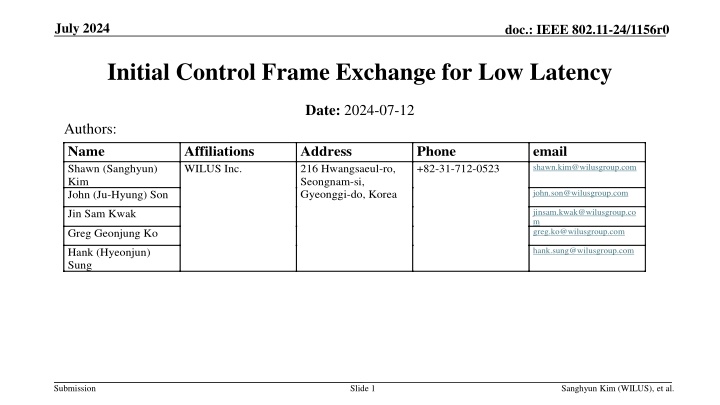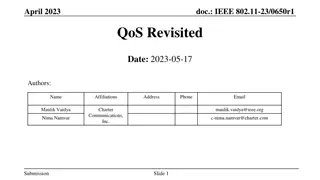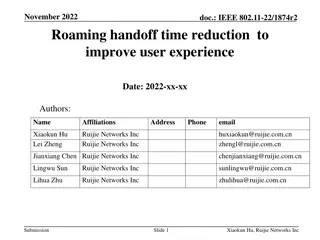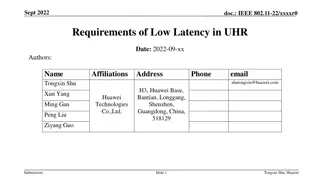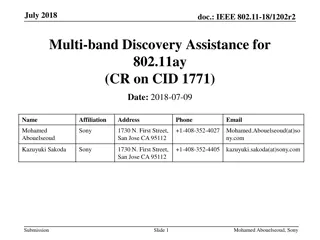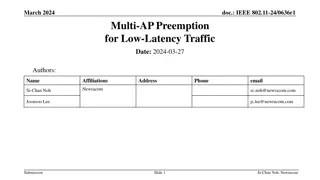Enhancing Low Latency in IEEE 802.11 Networks
Various mechanisms for low latency in IEEE 802.11 networks are discussed, including C-TDMA, C-RTWT, TXOP Preemption, and HiP-EDCA. This proposal aims to improve initial control frame exchanges to prioritize low latency traffic transmission. By modifying exchange rules and allowing STAs to signal their low latency requirements, the sequence of frame exchanges can be optimized for improved efficiency and reduced delays.
Download Presentation

Please find below an Image/Link to download the presentation.
The content on the website is provided AS IS for your information and personal use only. It may not be sold, licensed, or shared on other websites without obtaining consent from the author.If you encounter any issues during the download, it is possible that the publisher has removed the file from their server.
You are allowed to download the files provided on this website for personal or commercial use, subject to the condition that they are used lawfully. All files are the property of their respective owners.
The content on the website is provided AS IS for your information and personal use only. It may not be sold, licensed, or shared on other websites without obtaining consent from the author.
E N D
Presentation Transcript
July 2024 doc.: IEEE 802.11-24/1156r0 Initial Control Frame Exchange for Low Latency Date: 2024-07-12 Authors: Name Shawn (Sanghyun) Kim John (Ju-Hyung) Son Affiliations WILUS Inc. Address 216 Hwangsaeul-ro, Seongnam-si, Gyeonggi-do, Korea Phone +82-31-712-0523 email shawn.kim@wilusgroup.com john.son@wilusgroup.com jinsam.kwak@wilusgroup.co m greg.ko@wilusgroup.com Jin Sam Kwak Greg Geonjung Ko hank.sung@wilusgroup.com Hank (Hyeonjun) Sung Submission Slide 1 Sanghyun Kim (WILUS), et al.
July 2024 doc.: IEEE 802.11-24/1156r0 Introduction Various low latency-related mechanisms are under discussion for 11bn C-TDMA [1-5], C-RTWT SP [6-10], TXOP Preemption [11-15], HiP-EDCA [16, 17], etc. They have similar purposes that allow LL STAs to transmit LL traffic first by applying modifications on top of the baseline protocols In this contribution, we propose to enhance initial control frame exchanges to reorder the following frame exchange sequence to deliver LL traffic first Submission Slide 2 Sanghyun Kim (WILUS), et al.
July 2024 doc.: IEEE 802.11-24/1156r0 ICF/ICR exchange rules ICF/ICR exchange sequence defined in the baseline A STA that receives an RTS frame addressed to it shall respond with a CTS frame if medium is idle Similar rules are applied for the other control frames (e.g., MU-RTS, BSRP TF, etc.) Low latency-related problematic scenario based on the baseline rule A STA intending to transmit LL traffic receives an RTS frame, then it shall respond with a CTS frame and join the frame exchange sequence as a TXOP responder (LL traffic delayed) RTS PPDU (non-LL traffic) PPDU (non-LL traffic) 0 Non-LL STA CTS BA BA LL STA 3 LL STA acts as a TXOP responder (LL traffic transmission is delayed due to the initiated frame exchange sequence) LL traffic enqueued Submission Slide 3 Sanghyun Kim (WILUS), et al.
July 2024 doc.: IEEE 802.11-24/1156r0 ICF/ICR exchange rules (cont d) We can consider letting a STA having LL traffic to not respond to the received ICF by modifying the ICF/ICR exchange rule LL STA, after not responding to ICF, continues channel access procedure for its LL traffic transmission Modifying the ICF/ICR exchange rules seems beneficial for LL traffic transmission, but may cause the following problems: A STA transmitting an ICF for LL traffic transmission cannot obtain a TXOP when the recipient STA decides not to respond to the ICF If a STA doesn t respond to the received ICF, the ICF transmitter doubles the CW based on the failed ICF transmission Submission Slide 4 Sanghyun Kim (WILUS), et al.
July 2024 doc.: IEEE 802.11-24/1156r0 Proposal Two STAs inform each other about its LL requirement by using ICF/ICR The exchanged information can affect the following frame exchange sequence Case examples (w/ 1-bit LL/non-LL indication) Case 1: ICF (non-LL) & ICR (LL) After ICR, TXOP holder shares/allocates TXOP/RU to the TXOP responder Case 2: ICF (LL) & ICR (LL) After ICR, TXOP holder transmits its LL traffic first If there is remaining TXOP, the TXOP holder shares/allocates TXOP/RU to the TXOP responder Case 3: ICF (LL) & ICR (non-LL), ICF (non-LL) & ICR (non-LL) TXOP holder manages frame exchange sequence based on the baseline Submission Slide 5 Sanghyun Kim (WILUS), et al.
July 2024 doc.: IEEE 802.11-24/1156r0 Illustrations ICF (LL): Initial control frame w/ LL traffic indication ICR (LL): Initial control response w/ LL traffic indication TF: Basic/MU-RTS TXS Trigger frame RDG: Reverse Direction Grant Inserted sequence TF /RDG ICF Non-LL Data BA STA1 (non-LL) 0 ICR (LL) LL Data BA STA2 (LL) 3 LL traffic enqueued Case 1 frame exchange sequence LL traffic enqueued Inserted sequence ICF (LL) TF /RDG LL Data Non-LL Data STA1 (LL) BA 0 ICR (LL) LL Data BA STA2 (LL) 3 LL traffic enqueued Case 2 frame exchange sequence Submission Slide 6 Sanghyun Kim (WILUS), et al.
July 2024 doc.: IEEE 802.11-24/1156r0 Discussions ICF from Legacy STAs When the TXOP holder is legacy STAs, the frame exchange sequence cannot be modified based on the 11bn TXOP responder s low latency requirement Therefore, we may need to consider postponing TXOP initiation of legacy STAs by allowing an AP (with TBD conditions) not to respond to an ICF from legacy STAs The above TBD conditions should be carefully designed One condition could be R-TWT/C-RTWT SP An AP that received an ICF from a legacy STA during R-TWT/C-RTWT SP may not respond to the ICF Another condition could be LL traffic transmission An AP that has buffered LL traffic to a legacy STA may not respond to the ICF from that legacy STA (For further discussion) An AP that has buffered LL traffic may not respond to an ICF from legacy STAs Submission Slide 7 Sanghyun Kim (WILUS), et al.
July 2024 doc.: IEEE 802.11-24/1156r0 Discussions ICF under MLO There are cases where a non-AP MLD that received the ICF shall respond with an ICR and also shall change its operating mode e.g., a non-AP MLD with two EMLSR links may receive an ICF on EMLSR link-1 while trying to transmit LL traffic through EMLSR link-2 LL traffic transmission on the EMLSR link-2 will be delayed Note: An MLD w/ NSTR link pair has the similar issues It means that a STA affiliated with an MLD also needs to consider low latency requirements of the other links when deciding whether to respond to the received ICF Submission Slide 8 Sanghyun Kim (WILUS), et al.
July 2024 doc.: IEEE 802.11-24/1156r0 Summary Enhancements on the ICF/ICR for LL traffic have been discussed Enhancements on the initial frame exchange are proposed to reorder the following frame exchange sequence to deliver LL traffic first TXOP initiation of a legacy STA can be controlled by AP for certain conditions Frame exchange sequence between two MLD STAs should be managed based on low latency operation on the MLD links Submission Slide 9 Sanghyun Kim (WILUS), et al.
July 2024 doc.: IEEE 802.11-24/1156r0 Straw Poll 1 Do you agree to define a mechanism(s) to ensure that latency-sensitive traffic is transmitted with higher priority between TXOP holder and TXOP responder? Initial control frames (ICF/ICR) carry information to coordinate the order of frame exchanges within the corresponding TXOP. Details of the initial control frames are TBD. Submission Slide 10 Sanghyun Kim (WILUS), et al.
July 2024 doc.: IEEE 802.11-24/1156r0 Straw Poll 2 Do you agree that an UHR AP may not respond to the received initial control frame from non-UHR STAs when TBD condition(s) is met? One condition is that the initial control frame is received during R-TWT SP of its BSS Submission Slide 11 Sanghyun Kim (WILUS), et al.
July 2024 doc.: IEEE 802.11-24/1156r0 References [1] 11-23/1895r2 C-TDMA frame sequence Abhishek Patil [2] 11-24/0093r2 NAV setting for Coordinated TDMA Dibakar Das [3] 11-24/0411r0 TXOP Return in C-TDMA Geonhwan Kim [4] 11-24/0375r1 NAV protection for C-TDMA Si-Chan Noh [5] 11-24/0423r0 NAV Rules in C-TDMA Sanket Kalamkar [6] 11-23/2022r1 r-TWT for multi-AP follow up Laurent Cariou [7] 11-23/1916r1 R-TWT Coordination in Multi-BSS Sunhee Baek [8] 11-23/1952r3 Coordinated R-TWT for Multi-AP scenarios Follow up Liuming Lu [9] 11-24/0408r0 Enhancements on TWT SP Management Muhammad Kumail Haider [10] 11-24/0827r0 OBSS Interference Impact on CR-TWT and Enhanced Channel Access Rules Qing Xia [11] 11-23/1886r3 Preemption techniques to meet low-latency (LL) targets Giovanni Chisci [12] 11-24/0103r0 TXOP level preemption for Low latency application in 802.11bn Juan Fang [13] 11-24/0247r0 Legacy STA and OBSS Issues for Preemption Yunbo Li [14] 11-24/0390r0 A Uniform Procedure for Preemption Yunbo Li [15] 11-24/0470r0 rethinking-preemption Dmitry Akhmetov [16] 11-23/2126r3 Low latency channel access follow up Dmitry Akhmetov [17] 11-24/0840r0 hip-edca-proposal Dmitry Akhmetov Submission Slide 12 Sanghyun Kim (WILUS), et al.
